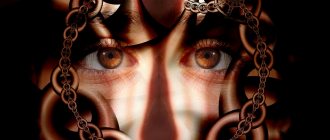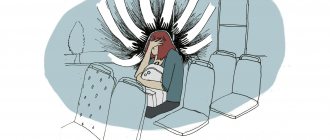What is dysphoria
Dysphoric disorder is characterized by a constant gloomy, gloomy mood with causeless irritability, anger, hysteria, and outbreaks of aggression arise completely spontaneously, for no apparent reason. The pathogenetic cause of this condition is a violation of the processes of production and reuptake of neurotransmitters - substances that are “responsible” for the transmission of nerve impulses and determine all the emotions experienced by a person.
It is the deficiency of norepinephrine, dopamine and serotonin that causes all the symptoms characteristic of dysphoria. In addition, such malfunctions in the functioning of the central nervous system often become the cause of other diseases, which, according to the modern classification, are combined into the group of psychosomatic disorders. To date, the connection between dysphoria and autoimmune pathologies, oncology, diseases of the cardiovascular and endocrine systems has been proven.
A hyperbolic reaction to even minor troubles increases the risk of heart attacks and strokes at an early age, chronic hypertension, and serious metabolic disorders.
There is a high probability of damage to the gastrointestinal tract (gastritis, colitis, pancreatitis); it has already been established that dysphoria is one of the main etiological factors of gallbladder dysfunction.
In psychology
From the point of view of psychologists, dysphoria is a negative emotion, manifested by low mood with gloominess, irritability and anger. In a state of dysphoria, a person is impatient and unrestrained; even a slight irritant can cause a violent reaction of anger and aggression. Like any negative emotion, it arises from a situation that is subjectively assessed as undesirable or unpleasant. Anyone can experience dysphoria, but those who are tired or sick often experience it, while those who are rested and healthy rarely experience it.
Causes
Dysphoria should be clearly differentiated from a bad, depressed mood caused by external circumstances. According to experts, neurotransmitter imbalances are based on:
- hereditary features of the functioning of the central nervous system;
- systematic alcohol abuse, drug use;
- organic brain damage as a result of severe traumatic brain injury, chronic hypoxia, or stroke.
However, even in the presence of these disorders, dysphoric disorder does not always develop. Symptoms of the disease can be caused by:
- overwork, too intense physical and mental stress;
- violation of daily routine, chronic lack of sleep;
- stress caused by any problems in the family or at work;
- withdrawal syndrome due to sudden withdrawal from psychostimulants;
- conflicts with loved ones, colleagues;
- psychotrauma;
- hormonal imbalances caused by any disease or physiological age-related changes;
- serious illness diagnosed in oneself or relatives, etc.
Dysphoria is a symptom of a number of other psychoneurological diseases:
- depression;
- post-traumatic, generalized anxiety disorder;
- psychosis;
- neuroses and neurasthenia;
- schizophrenia, etc.
Symptoms
In a state of dysphoria, a person looks gloomy, tense and wary. When communicating, such people are rude, prone to petty touchiness and picky. Characterized by increased sensitivity to sound, smell, bright light, and touch. There are almost always somatic manifestations in the form of increased heart rate, breathing, impaired muscle tone (convulsions, twitching, tics) and vegetative symptoms. With severe dysphoria, aggressive behavior towards oneself (self-cutting, self-harm) or towards others (insults, threats, beatings, etc.) is possible.
Clinical manifestations
The main signs of dysphoria include:
- apathy;
- melancholy;
- decreased performance, exercise intolerance;
- anxiety, restlessness;
- unpredictable outbursts of anger and aggression, physical violence and attempted attacks are not excluded;
- offensive, malicious statements addressed to others.
In addition, dysphoria is often accompanied by somatic disorders:
- insomnia with nightmares;
- weakness, weakness;
- shortness of breath;
- headache, tachycardia;
- pulsation in the temples and ears, especially during attacks of anger;
- paroxysmal or chronic pain in the chest, abdomen;
- eating disorders (worsening of appetite or, conversely, overeating, anorexia, bulimia);
- deterioration of the condition of the skin, hair and nails;
- menstrual disorders, decreased libido, and in men - impotence.
Dysphoric disorder also causes serious disturbances in the functioning of the immune system , which reduces the body's resistance to various types of viral and bacterial infections.
What is Premenstrual Dysphoric Disorder/Syndrome
Premenstrual dysphoric disorder (PMDD), also known as premenstrual dysphoric syndrome (PMDS), can be considered a significantly more intense, severe or severe form of premenstrual syndrome (PMS) with similar symptoms, but the degree of their severity interferes with a woman's usual daily activities and activities.
Among menstruating women, PMDD occurs in 3-8% of cases.
PMDD is effectively treated with medications, including antidepressants (usually SSRIs), anxiolytics, and drugs that suppress ovulation and ovarian hormone production. Non-drug psychotherapy methods are effective and have no side effects.
Diagnostic and treatment methods
To determine how to treat dysphoria, medical specialists need to find out the exact cause of the disorder and identify possible concomitant diseases. Often, questionnaires and psychotherapeutic testing are not enough, and additional laboratory and instrumental studies are needed:
- EEG, Dopplerography, brain tomography;
- determination of hormonal levels;
- Ultrasound of internal organs;
- ECG, ECHO-CG;
- according to indications - screening for autoimmune and oncological diseases.
The main method of treating dysphoria is regular consultations with a psychologist . Psychoanalysis and cognitive behavioral psychotherapy will help the patient cope with internal tension and more easily experience conflict and stressful situations.
Non-drug methods for correcting dysphoria are of great importance:
- art therapy;
- proper nutrition (if necessary, we help create a rational diet for weight loss/gain);
- physical exercise;
- daily walks in the fresh air;
- activities that distract from work and everyday worries.
How is PMDD diagnosed?
PMDD must be distinguished from other physical and psychological conditions that can cause the same symptoms. Differential diagnosis (a list of conditions that can cause the same symptoms) includes mood disorders, depression and anxiety disorders, and thyroid disease. In addition to a thorough history and physical examination, blood tests may be ordered to rule out diseases that may explain symptoms similar to PMDD.
If a woman suspects she has PMDD, it is recommended that she complete a symptom chart or monthly cycle calendar, noting her physical and psychological changes every day for at least two months. The symptom chart can be compared to a menstrual calendar to illustrate the relationship of symptoms to the menstrual cycle.
If PMS is diagnosed based on symptoms from the woman’s words, then premenstrual dysphoric syndrome is diagnosed based on clinical criteria.
To be diagnosed with PMDD, a woman must experience at least five of the following symptoms in the week or two before her period. In this case, these symptoms should disappear within a few days after the start of menstruation and should not be explained by another disorder. These are symptoms that interfere with a woman's daily activities and activities and are not the result of another disorder or disease.
- Feelings of sadness, hopelessness, or self-deprecation
- Feeling tense, anxious, or on edge
- Noticeable mood changes, sadness, or tearfulness
- Increased irritability, anger, increased conflict in interpersonal relationships
- Decreased interest in regular activities, social activity, and communication.
- Difficulty concentrating
- Feeling tired, sluggish, or lacking energy
- Noticeable changes in appetite, which may be associated with overeating or craving certain foods.
- Hypersomnia (excessive sleeping) or insomnia
- Subjective feeling of depression
- Breast tenderness or swelling
- Headache
- Joint or muscle pain
- Bloating (flatulence)
- Weight gain
Cost of services
| CONSULTATIONS OF SPECIALISTS | |
| Initial consultation with a psychiatrist (60 min.) | 6,000 rub. |
| Repeated consultation | 5,000 rub. |
| Consultation with a psychiatrist-narcologist (60 min.) | 5,000 rub. |
| Consultation with a psychologist | 3,500 rub. |
| Consultation with Gromova E.V. (50 minutes) | 12,000 rub. |
| PSYCHOTHERAPY | |
| Psychotherapy (session) | 7,000 rub. |
| Psychotherapy (5 sessions) | 30,000 rub. |
| Psychotherapy (10 sessions) | 60,000 rub. |
| Group psychotherapy (3-7 people) | 3,500 rub. |
| Psychotherapy session with E.V. Gromova (50 minutes) | 12,000 rub. |
| TREATMENT IN A HOSPITAL | |
| Ward for 4 persons | 10,000 rub./day |
| Ward for 3 persons | 13,000 rub./day |
| Ward 1 bed VIP | 23,000 rub./day |
| Individual post | 5,000 rub. |
| PETE | 15,000 rub./day |
This list does not contain all prices for services provided by our clinic. The full price list can be found on the “Prices” , or by calling: 8(969)060-93-93. Initial consultation is FREE!
Drug treatment
Medicines are prescribed when there is no visible effect from psychotherapy. To minimize the risk of adverse reactions and complications, the treatment regimen is always selected on an individual basis. Apply:
- mood stabilizers (lithium salts);
- sedatives and hypnotics (short-term course until the general psycho-emotional state is normalized);
- B vitamins, antioxidants;
- medications for the correction of concomitant diseases.
But most often, antidepressants are used, which act directly on the pathogenetic mechanisms of the development of dysphoria.
Ideally, treatment should begin as quickly as possible, without waiting for the depressive state to worsen and the development of concomitant psychosomatic diseases. To make an appointment, call us 24 hours a day 8(969)060-93-93.
ACADEMY OF MEDICAL SCIENCES USSR ALL-UNION RESEARCH CENTER FOR MENTAL HEALTH
As a manuscript
ZHARIKOV Mikhail Nikolaevich
UDC 616.895.4-06 : 616.89-008.428.1 )-036.1
PSYCHOPATHOLOGY AND CLINIC OF DYSPHORICA
STATES IN THE STRUCTURE OF ENDOGENOUS
DEPRESSION
(psychiatry — 14.00.18)
Abstract
dissertations for an academic degree
candidate of medical sciences
Moscow - 1985
The work was carried out at the Department of Psychiatry of the Central Order of Lenin Institute for Advanced Medical Studies.
Scientific supervisor - Head of the Department of Psychiatry, Professor A. S. Tiganov.
Official opponents:
Doctor of Medical Sciences G. P. Panteleeva,
Doctor of Medical Sciences, Professor B.V. Shostakovich.
The leading institution is the Department of Psychiatry of the Order of Peoples' Friendship of the Peoples' Friendship University. P. Lumumba (Head of the Department of Psychiatry - Doctor of Medical Sciences, Professor M.V. Korkina).
The defense will take place 20 , 1986 at a meeting of the specialized council at the All-Russian Scientific Center for Medical Protection of the USSR Academy of Medical Sciences (council code - D.001.30.01) at the address: Moscow, Kashirskoye Shosse, 34.
The abstract was sent out on November 27, 1985. The dissertation can be found in the library of the All-Russian Scientific Center for Public Health of the USSR Academy of Medical Sciences.
Scientific Secretary
specialized council
Doctor of Medical Sciences
V. D. Moskalenko
Relevance of the problem. States of increased irritability are widely described within the framework of endogenous depression. In 75% of depressed patients, the reason for contacting a psychiatrist is irritability and a constant readiness to “explode” (F. Eid, 1980). Anger and rage, according to S. Lesse (1980), are one of the most common manifestations of masked depression.
The definition of the nature of increased irritability in endogenous depression is heterogeneous: depressive disorders of the dysphoric type are distinguished, characterized by a gloomy, gloomy mood, with a predominance of irritability, anger, wariness and a feeling of dissatisfaction with the environment (B.M. Morozov, 1969, A.D. Pchelina, 1979). Endogenous depressions with dysphoric overtones are described (I.A. Rodionov, 1967; A.B. Smulevich, 1970; B.M. Shamanina, T.E. Romal, V.A. Kontsevoy, 1971; A.V. Ulezko, 1971; N.A. Mazaeva, 1983, etc.).
Foreign psychiatry also describes dysphoria and depression, characterized by sadness, a sense of one’s own unhappiness, and depression (Carlson Cantwell, I980; Strauss
Carpenter, 1981, etc.) or a recurring tendency towards gloomy despair (Gerevanian Akiskal, 1979).
Thus, increased irritability or dysphoric manifestations are quite characteristic of endogenous depression, however, the scope of application of the concept of dysphoria is wide, and the interpretation of the term is ambiguous. There is no clear clinical and psychopathological description of dysphoric states in the structure of endogenous depression; the issues of early detection of dysphoria and the role of endogenous factors in their formation have not been studied. The issues of choosing adequate therapeutic tactics and preventing dysphoric conditions have not been resolved. Solving all these issues is an important and urgent task,
contain theoretical and practical significance.
Goal of the work. Psychopathological description of dysphoric conditions that arise within the framework of endogenous depression, determination of patterns of dynamics and taxonomy of these conditions, as well as the rationale for a differentiated approach to the therapy and preventive treatment of dysphoric conditions.
Main objectives of the study. I. Study the psychopathological structure of dysphoria, explore their possible variants, and give a typological description of the main parameters. 2: to study the dependence of the structure of dysphoria on the nature of the schizophrenic process (the relationship of the nature and depth of dysphoric states to other psychopathological disorders). 3. To study the features of schizophrenia occurring with dysphoric manifestations (the ratio of dysphoric and other psychopathological disorders). 4. Study the formation, development and dynamics of dysphoria within the framework of endogenous depression. 5. Determine the comparative effectiveness of treatment of dysphoric conditions with various drugs (antidepressants, sedatives, tranquilizers, etc.) and develop recommendations for the preventive treatment of dysphoric conditions.
The work consists of 6 Chapters. Chapter I provides a literature review. Chapter II provides characteristics of the material. Chapter III is devoted to the psychopathological description of dysphoric states in the structure of endogenous depression. Chapter IV provides a clinical description of the features of schizophrenia with dysphoria in the structure of depression. Chapter V - treatment of depression with dysphoric manifestations. Chapter VI - Conclusion. The final section of the text provides five conclusions. The bibliography index contains 128 sources. Of these, 69 are domestic authors and 59 are foreign.
Scientific novelty. This work is the first to conduct special studies of dysphoric states that arise in the structure of endogenous depression. A taxonomy of dysphoria is given, depending on the nature of external manifestations (dysphoria with aggressive behavior, a tendency to solitude, or special physical activity). Descriptions of the features of dysphoric states in the structure of simple and complex endogenous depression are given. The patterns of formation of dysphoric states depending on the nature of the manifest attack have been identified. The states of increased irritability that precede the appearance of dysphoric states proper are described, and the dynamics of dysphoric states are studied. Data were obtained on the influence of various exogenous factors on the manifestations of dysphoric states.
An assessment is made of the effectiveness of the use of various medications for the treatment of patients suffering from depression and dysphoric conditions. The principles of preventive treatment of dysphoria have been developed.
Practical value. A detailed psychopathological description of dysphoric states that arise as part of endogenous depression is of great practical importance for the correct diagnosis of these conditions, as well as for resolving issues of differential diagnosis. A number of features, as well as the dynamics of the development of dysphoric states, are one of the factors in the differential diagnosis of schizophrenia and epilepsy. Identification of precursors of dysphoric states is one of the prognostic criteria for assessing the further course of the disease. The identification of dysphoric states in the structure of endogenous depression allows us to take a fresh look at the aggressive behavior of a number of depressed patients in a forensic psychiatric aspect. Therapeutic recommendations make it possible to promptly and quickly relieve dysphoria. Prevention of dysphoric conditions
leads to a reduction in the duration of inpatient treatment, and also prevents hospitalizations associated primarily with social
but everyday conflicts.
The following provisions are submitted for the defense of the dissertation:
1. Dysphoric states quite often develop in the structure of endogenous depression in paroxysmal-progressive schizophrenia.
2. Dysphoria is a complex condition in which a complex of psychopathological disorders is distinguished.
3. Dysphria that occurs as part of endogenous depression has a number of features unique to them.
4. The appearance of dysphoria is preceded by a period of increased irritability, the duration of which is determined by the nature of the manifest attack.
5. Therapy for dysphoria should be comprehensive and include, first of all, the treatment of depression in which it occurs.
Approbation of work. The main provisions of the dissertation were presented at conferences of young scientists TsOLIUv, held in 1983 and 1994. The dissertation was approved at a meeting of the Department of Psychiatry TsOLIUv / May 1985/
Publication of research results.
Before the research materials, 3 works were published, a list of which is given at the end of the abstract.
Research methods and characteristics of clinical observations.
The solution to the assigned tasks was carried out using a systematic approach, with a comprehensive assessment of the data obtained. A clinical-psychopathological method was used to study patients undergoing treatment and examination in a hospital.
The collection of clinical data was carried out according to specially compiled
ny questions, which reflected information about heredity, family and social status, early development, previous diseases and brain injuries, the course of diseases, as well as the treatment of patients. Particular attention was paid to the study of the emergence, formation, dynamics of increased irritability and dysphoric states.
In an effort to create an objective picture of the course of the disease and characteristics of the patient’s personality, we used additional sources of information (information from relatives of patients and medical documentation data - archival medical histories, extracts from other medical institutions.
The work included data from a study of 70 patients with dysphoria in the structure of endogenous depression - 7 men and 63 women. The main contingent of patients (49 people) was aged from 20 to 50 years. All patients suffered from schizophrenia, which proceeded in a paroxysmal-progressive manner. Depending on the duration of the disease, patients were distributed as follows: up to 10 years - 32 observations, from 10 to 20 years - 30 observations, over 20 years - 8 observations.
Psychopathological features of dysphoria. arising in the structure of endogenous depressions. The present study showed that dysphoric states arose both in the structure of simple and complex endogenous depression. We classified as simple endogenous depression states with a depressed, melancholy mood, ideational and motor retardation, sleep and appetite disturbances, as well as daily mood fluctuations (A.V. Snezhnevsky, 1983). When disorders appear that go beyond the scope of affective disorders themselves, such as, for example, delusional or hallucinatory disorders, we considered depression as complex (AD. Pchelina, 1980; A.V. Snezhnevsky, 1983). Of the 70 patients examined, in 47 dysphoria developed in the form of simple endogenous depression and in 23 in
complex structure. Among the variants of simple endogenous depression, adynamic (24 observations), melancholic (19 observations) and depression with features of both adynamic and melancholic (4 observations) were noted.
Within the framework of dysphoric conditions that arose in the structure of simple endogenous depression, we identified emotional manifestations, special forms of behavior (aggression towards others, destructive tendencies towards things, etc.), hypersthesia, senestopathies, hallucinations of general feelings and sopatho-vegetative disorders .
Emotional manifestations were very diverse: patients noted increased irritability; often the source of irritation at the time of the onset of dysphoria were objects and phenomena that had not previously bothered the patient or attracted his attention. If there were no reasons for the manifestation of irritation in the environment, the patients provoked a conflict situation. Irritability was accompanied by anger, swearing, and insults directed at a relative or loved one. Quite often, patients suddenly developed a feeling of hatred towards those around them, both acquaintances and complete strangers. The reason for hatred was associated by patients with the fact that those around them could mind their own business, laugh, while they “feel so bad at heart.” Often, hatred of others was explained by a feeling of inferiority, illness, lack of family, frequent hospitalizations, etc.
In a third of patients during the dysphoric state, a feeling of internal mental tension prevailed, with a constant expectation of an impending catastrophe. Less frequently, fear, anxiety, melancholy, dissatisfaction, and indifference, which had a pronounced anesthetic coloring, arose in the structure of the dysphoric state. Sick
they spoke of extreme irritability and malice, while complaining that the soul was “empty, frozen” and the anger came not “from the heart, but from the mind.”
Depending on the nature of the external manifestations of dysphoric states that arose in the structure of simple endogenous depressions, they were divided into three groups.
The first and largest group of patients (24 observations) was characterized by aggression directed at others, destructive tendencies and conflict (most often in the form of obscene language and threats).
Direct aggression towards others was observed quite rarely (3 observations); destructive tendencies were observed much more often (17 observations). In cases where irritability reached its highest point, patients began to break dishes and throw objects around. The conflict behavior of patients was expressed, as a rule, in obscene language and threats. The patients threatened to kill, but these threats were practically never implemented (4 observations).
The second group (12 observations) was represented by patients in whom the development of a dysphoric state was accompanied by a desire for solitude, sometimes so strong that the patients went to bed and covered their heads with a blanket so as not to see anyone or hear anything. After this condition passed, the patients said that they felt “hatred for the whole world” at that moment. The patients had clearly expressed symptoms of hyporsthesia; the slightest noise was perceived by them as extremely painful and could serve as a source; severe irritation. Thus, the quiet conversation of the patient’s relatives coming from another room could cause an outbreak of extreme irritability and anger, however, the strong noise on the street was indifferent to the patient. Some correction of behavior in patients in some cases depended on the situation.
And finally, the third group / II observations /; the external manifestation of dysphoric states in these patients was expressed in the desire for vigorous activity, which was untargeted. So, they began to wash clean linen, walk quickly around the apartment, etc. In cases where someone at this moment turned to the patient with questions or comments, then two types of reactions were possible: either the patient became extremely angry, began to curse, could attack the person who disturbed him with his fists, or withdrew from communication and tried to hide in secluded place.
A number of manifestations of dysphoric states were accompanied by a complex of psychopathological and somato-vegetative disorders.
Psychopathological disorders were represented by dysphoric hyperesthesia, senestopathies and hallucinations of general feeling. Dysphoric hypersthesia, in addition to intolerance to loud sounds, bright light, etc., was accompanied by internal tension and a lowered threshold of sensitivity to all external stimuli.
Senestopathies with dysphoria were observed in all patients and were extremely varied. The patients felt that they were shaking, pounding, everything inside was compressing, as if something was growing, expanding, bursting.” These sensations were extremely unpleasant and painful for the patients, while they were non-specific, non-localized, very unstable and did not reach a significant degree of severity. Senestopathies were also noted, which were more pronounced and localized: patients complained of a feeling of heat in the face, burning pain in the heart area. These senestopathies were more persistent and did not persist throughout the entire dysphoria. Isolating hallucinations of a general feeling is necessary, since the extreme pretentiousness and lack of an element of comparison in some formulations of patients does not allow
We should attribute the sensations that arise only to senestopathies. Thus, in one observation, the patient spoke about the feeling that “the chest is filled with stones” at the height of dysphoria. In another observation, the patient, describing her feelings at the moment of dysphoria, said that she felt so bad, “as if someone had slashed her throat with a knife and blood was gushing out.”
Of the somato-vegetative disorders, almost all patients had tachycardia; in some cases, patients spoke about sweating and a rush of blood to the hands, which they noted as redness and moistening of the hands.
A feature of the attitude of patients towards their dysphoric states should be considered the feeling of remorse that arises after the dysphoria has passed. The vast majority of patients, after the end of dysphoria, felt shame, regretted their behavior, asked for forgiveness, and blamed themselves for “rude behavior.”
The duration of dysphoric states in our cases ranged from several minutes to a day. However, in the vast majority of observations, dysphoria lasted from one to one and a half hours.
There was a fairly clear relationship between the duration of dysphoria and the severity of its manifestations. The longer the dysphoric state was, the less acute it manifested itself. Describing dysphoric states that arise in the structure of simple endogenous depression, it should be noted that in 5 patients included in this group, the appearance of dysphoria was preceded by the development of special “precursors” in the form of a feeling of pressure, an increase in something unpleasant in the “soul”, a gradual increase irritability. These sensations appeared from several days to several hours before the development of dysphoria.
In 23 patients, dysphoric states arose in the structure of a complex
them endogenous depressions.
Based on the nature of dysphoric states, observations are divided into two groups. The first group included patients with dysphoric conditions similar to those described in simple endogenous depression, the second group included patients whose dysphoric conditions differ significantly from the dysphoria described in simple endogenous depression.
Dysphoric states in patients included in the first group (13 observations) were characterized by almost the same manifestations as in cases of simple endogenous depression. They were also quite long (from 30 minutes to one day), included various affective manifestations (irritability, anger, hatred, melancholy, fear, etc.), depending on the nature of the external manifestations of dysphoric states in patients of this group It is also possible to identify such forms of bringing about the moment of dysphoria as aggression towards others or destructive tendencies towards things, the desire for solitude or vigorous activity. All patients also had a number of somato-vegetative disorders, various senestopathies, and hallucinations of general feeling. These patients were also characterized by a feeling of remorse that came after the end, dysphoria.
Dysphoric states in patients included in the second group (9 observations) were also characterized by sudden onset and sudden resolution in the form of the implementation of aggressive tendencies, a feeling of relief that comes after the end of dysphoria, a similar nature and strength of manifestation of affective disorders, the presence of somato-vegetative disorders, senestopathies and hallucinations of general feeling. However, they also differed in a number of features; arose only at the stage of advanced complex endogenous depression and were closely related
are known about psychopathological disorders of the non-affective register; in most cases, dysphoria in such patients was manifested by aggression towards others. At the time of the development of dysphoria, patients experienced a pronounced increase in psychopathological disorders of the ineffective register - auditory and visual deceptions of perception significantly intensified, delusional disorders acquired particular brightness and distinctness . As an important feature of dysphoric states in such patients, it should be noted their complete isolation from the actual events taking place. The nature of the experiences at the time of dysphoria in patients was associated only with hallucinatory or delusional disorders.” In such patients, interpretation of purely everyday causes of dysphoria was almost never noted, which was typical for all previously described types of dysphoric states. Patients in this group never showed a tendency towards solitude or a desire for active activity; dysphoria was usually very short-lived, their duration did not exceed one hour. The patients never experienced a feeling of remorse or regret about their actions.
In some patients (2 observations), which we classified as the second group, there was both dysphoria characteristic of complex endogenous depression and dysphoria characteristic of simple endogenous depression. The presence of two variants of dysphoric states in one patient indicates a close connection between dysphoria in simple and complex endogenous depression. This is also confirmed by the fact that if such patients developed dysphoria characteristic of simple endogenous depression, they acquired features characteristic of dysphoria arising in the structure of complex endogenous depression. Thus, the line between the manifestations of the two types of dysphoria in these patients was practically erased.
Clinical features of schizophrenia occurring with dysphoria in the structure of depression. Significant features of the case study clinic include the presence of a certain relationship between the psychopathological manifestations of a manifest attack and the stage of formation and development of increased irritability that precedes the appearance of dysphoric states.
The manifestation of schizophrenia, depending on the severity and presentation of affective disorders, manifested itself in three variants: affective-delusional with a low proportion of affective disorders, affective-delusional with a high proportion of affective disorders, and affective. Each of the variants of the manifest attack corresponded to its own version of the period of increased irritability in the structure of endogenous depression: short, medium duration, long.
A manifest affective-delusional attack with a low proportion of affective disorders (15 observations) was characterized by pronounced severity and polymorphism of psychopathological symptoms. Its structure included auditory and visual pseudohallucinations, delusional disorders, catatonic disorders, phenomena of depersonalization and derealization. The presence of massive psychopathological symptoms of ineffective registers, and especially pronounced hallucinatory and delusional disorders that come to the fore, determined the name of this variant of the manifest attack. The proportion of affective disorders proper was low compared to hallucinatory and delusional disorders. Affective disorders manifested themselves in the form of anxious, melancholic or adynamic depression, which developed at the stage of formation of a manifest attack. Such patients, in addition to low mood, were bothered by a feeling of vague anxiety, a vague expectation of bad changes in life, all this could
accompanied by a growing feeling of fear of going crazy, the surrounding reality was filled with a hidden threatening meaning. When these disorders reached their peak, delusional and hallucinatory disorders themselves appeared, so acute and massive that they quickly pushed depressive symptoms into the background.”
With the reduction of psychopathological symptoms, first of all, disorders of ineffective registers disappeared - catatonic symptoms, hallucinatory and delusional disorders, phenomena of depersonalization and derealization. As psychopathological symptoms are reduced; ineffective registers, affective disorders in the form of adynamic depression increasingly came to the fore - patients were worried about weakness, fatigue, they always wanted to lie down, did nothing during the day, felt especially bad in the morning, in the evening - somewhat better, mood lowered, but without melancholy or anxiety, but rather with a feeling of hopelessness. All this was accompanied by sleep and appetite disorders. After the disappearance of the symptoms of adynamic depression, the patients were discharged home.
The described type of manifest attack corresponded to a short-term period of increased irritability in the structure of endogenous depression. This period was not closely related to the manifest attack in time - it could occur several years after the manifest attack, and in some cases (3 observations) before the manifest attack. The nature of the manifest attack correlated only with the duration of the period of increased irritability, the duration of this period was 1-3 years, it was characterized by the appearance of increased irritability in the structure of cyclothymocysodes-like depressions that occurred at the outpatient level, i.e.
most often within the framework of affective fluctuations in interictal periods.
In 4 observations, increased irritability developed in the onset of affective disorders, repeated affective-delusional attack.
And in 3 observations, the stage of the appearance of increased irritability developed within the framework of erased depression that arose before the onset of a manifest attack. A period of increased irritability immediately preceded the onset of dysphoric states.
The group of patients who suffered a manifest affective-delusional attack with a high proportion of affective disorders is the most numerous (35 observations). The manifest attack in these patients was characterized by severe depressive, delusional and hallucinatory symptoms. Affective disorders were represented by anxious and adynamic depression. Affective disturbances in this variant of the manifest attack were equally pronounced throughout its entire duration.
Delusional symptoms were represented by ideas of self-accusation and self-deprecation (19 observations) and delusions of persecution (16 observations), which were of a sensual nature. The patients accused themselves of committing the most serious crimes, and “confirmed” the presence of surveillance and persecution by the same people?
Deceptions of perception were represented only by auditory hallucinations, which were distinguished by their pronounced uniformity. “Voices” insulted the patients, accused them of committing crimes, and threatened them.” This exhausts the psychopathological disorders noted in the structure of this variant of the manifest attack,
This variant of the manifest attack corresponded to a period of increased irritability lasting from 3 to 9 years. Increased
Significant irritability arose in the structure of interictal depressive cyclothyme-like states and depressive manifestations of repeated episodes. The period of increased irritability passed into the stage of the appearance of dysphoric states proper.
And finally, the third variant of a manifest attack is affective /20 observations/. The manifest affective attack was distinguished by the duration and lack of severity of its manifestations. The duration of the attack averaged a year. The psychopathological manifestations of the attack were represented by adynamic and melancholic depression. In the first case, patients were worried about low mood, weakness, lethargy, and reluctance to do anything; in the second case, in addition to the described symptoms, the patients were bothered by “melancholy, “heaviness in the soul.” In the manifestations of adynamic and melancholic depression, daily mood fluctuations were noted.” In both cases, patients were bothered by severe disturbances in sleep, appetite and the menstrual cycle in women.
The period of observed irritability in the structure of autogenic depression was long (from 10 years and above). Increased irritability could appear as part of inter-attack affective fluctuations or affective disorders of the subsequent attacks themselves. The nature of the increased irritability that appears, both within an attack and in inter-attack affective fluctuations, differs little. In general, the dynamics of increased irritability were similar to those in the two previous variants of the stage of appearance of increased irritability; Once it has arisen, increased irritability appears within each subsequent affective / depressive / state and becomes more and more pronounced.
longer period of time than in the first two cases,
Next, we would like to specifically focus on the dynamics of dysphoric states. During the development of the disease, all patients with dysphoria underwent a number of changes, manifested in an increase in the duration and frequency of these states. In the overwhelming majority of patients, in addition to the above changes, changes in the nature of dysphoric states were also observed. These changes were primarily manifested in an increase in the brutality of dysphoric affect: the patients’ control over their actions weakened more and more, and their behavior became more and more aggressive. All these changes were only to some extent associated with corresponding changes in the nature of depression: an increase in depressive states in most cases was accompanied by an increase in dysphoria, however, an increase in brutality was not necessarily accompanied by a deepening of depression." On the contrary, patients could note that a decrease in mood was more easily tolerated, and "anger " worries more and more. Thus, although dysphoric states arose in the picture of endogenous depression, their dynamics were not completely related to the dynamics of depression themselves.
Treatment of dysphoric conditions that arise in the structure of endogenous depression. The issues of treatment and prevention of dysphoric conditions are extremely important. Firstly, patients in a state of dysphoria often pose a threat to others and themselves (with auto-aggressive actions); secondly, conflict and aggressive behavior of patients is often the main reason for hospitalization.
In the treatment of dysphoric conditions, we distinguish two directions: the use of primary and additional therapy.
Primary therapy means the use of drugs that act on the symptoms of simple or complex endogenous
depression. These include antidepressants / amitriptyline, meliaramine, etc. / and psychotropic drugs that affect delusional or hallucinatory symptoms / stelazine, triftazine, haloperidol, etc./. Timely administration and use of them in appropriate dosages significantly reduces the risk of dysphoric conditions.
As additional therapy, medications were used to eliminate dysphoria at the time of its occurrence or with a pronounced increase in irritability in patients. These include: aminazine, tizercin, seduxen /relanium/, tazepam, elenium, radedorm, etc. The effectiveness of these remedies was greater if they were used against a background of increased irritability, when affect dysphoria occurred, and was weaker.
As a prophylactic agent, we have used fin-
lepsin. The effect of using this drug was especially high if
it was prescribed 1 - 2 days before the onset of the dysphoric state,
what was possible in the presence of precursors of dysphoria in the form of an increase
irritability that appeared several days before the onset of dysphoria. In the absence of precursors, it is advisable to use finlepsin in small doses throughout the depression:
Conclusions.
1. The psychopathological content of the term “dysphoria” is sufficiently fully defined only in epilepsy, while in other mental illnesses the interpretation of the term is ambiguous, especially in diseases occurring with affective pathology, where these conditions occur quite often.
2. The study of dysphoria in the picture of endogenous depression made it possible to identify variants of dysphoric states: dysphoria with aggressive behavior, destructive tendencies and conflict behavior of patients;
dysphoria about a pronounced tendency to solitude; as well as dysphoria, in which the behavior of patients manifested itself in a pronounced desire for activity, in some cases meaningless.
3. In the dynamics of the disease, the development of dysphoria was preceded by a period of increased irritability, the duration of which was in strict accordance with the clinical features of the disease: the higher the proportion of affective disorders in the structure of the manifest attack, the longer the period of increased irritability.
4. Studying the course of schizophrenia with dysphoric states was intended to reveal their dynamics in the picture of depression, manifested in an increase in the duration and frequency of dysphoria, an increase in the brutality of behavior at the time of dysphoria, a gradual loss of control and a decrease in criticism. The dynamics of dysphoric states are related to the dynamics of depression, in the structure of which they arise: with the increase in depression, there is an increase in dysphoric states.
5. Experience in treating patients with dysphoria in the structure of endogenous depression indicates the need for complex therapy, taking into account the characteristics of the course of the underlying disease. First of all, it is necessary to treat depressive states (simple or complex), in which dysphoria occurs. The use of medications aimed at preventing dysphoric conditions allows not only to control and prevent them, but also increases the overall effectiveness of therapy.
List of works published on the topic of the dissertation:
1. On the issue of dysphoric states in the structure of endogenous depression. GRM, 1983, section 14, no. 6, publication 731.
2. Features of dysphoric states that arise as part of endogenous depression. Journal neuropathol. and psychiatrist. them. S.S. Korsakova, 1984, issue. 12, p. 1844 - 1848.
3. Definition and limits of application of the concept of “dysphoria” in modern psychiatry / Review /. Journal neuropathol. and psychiatrist. them. O.S. Korsakova, 1965, issue. 4, p. 609 - 612.
What is the cause of postcoital dysphoria?
There is not much literature on this topic. As a result, we have only a limited understanding of why this phenomenon occurs. However, research suggests that the most obvious antecedents are genetics, personality characteristics (such as higher emotional reactivity), and attachment patterns (especially anxious and avoidant).
In addition, some women experience negative experiences after sexual intercourse due to childhood experiences of sexual abuse and trauma. However, this is only part of the possible reasons; we still have to find out the rest.
How to distinguish dysphoria from depression
You can distinguish a dysphoric attack from depression by the following signs:
- The dysphoric state appears and goes away suddenly and sharply. It looks like seizures. Depression develops gradually, is persistent, and rarely goes away on its own.
- In a depressed state, a person feels better when he sees positive emotions. With dysphoria, an individual wants to make others feel even worse than themselves. Realizing this fact makes him feel better. He is aggressive, sensitive to the words and actions of other people.







